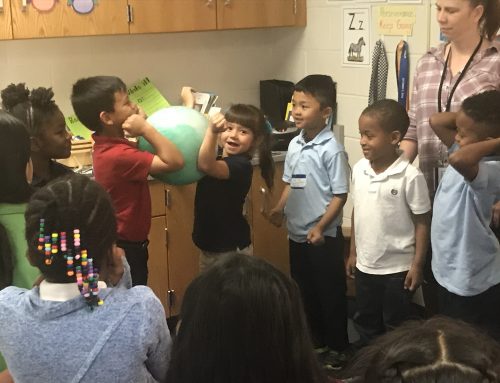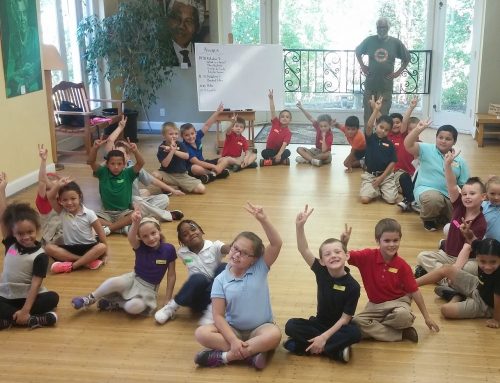This blog was written by our Youth Programs Director, Kristina Hulvershorn.
Restorative Justice, Restorative Practices, Restorative Circles…all of the names and definitions can get confusing so we want to share a few stories that show you why we are so proud of this work. These are all stories from the last 2 months of work in IPS schools by our Peace Learning Center team.
It is about people helping themselves
Two teenagers at a high school get sent out of class. Their words were escalating and it looked like they might fight. One restorative circle later we find out the complexities of their relationship and the two of them are able to reconnect and make a plan for how to get along in the future without disrupting class. One participant said that the process was refreshing because it felt good to talk it through the right way and was grateful for the opportunity. They didn’t need to be told that they were wrong or what to do. Neither student needed to be punished in order to learn something or do the right thing. They came up with a solution on their own and were back in the class within 20 minutes.
It is about changing how we view children
After a circle with a full elementary class, who had been experiencing a number of problems with disruptions and negative behaviors, the teacher remarked “I have never seen them take responsibility for their actions like that!” Students were given the power and the space to understand that their actions have consequences and to come up with a way to improve things on their own terms. In addition, trust was built within their classroom community and was strong enough to allow them to feel safe taking ownership of their own actions. Imagine suspending students for this problem. The community would have been further fractured and pulled apart– exactly the opposite of what it needed.
It is about unexpected victories
Some of the most illuminating restorative work we do happens when we there are strained relationships between students and teachers. Often “challenging students” have lived lives full of trauma and are reacting to language or situations that unintentionally provoke them. One student explained that he skipped class because his teacher regularly humiliates him in front of the entire group and he feels so embarrassed he leaves. Another student told us that he was so tired of changes (multiple teachers this year) that he contributed to the chaos in his classroom because “I just don’t like change” Just being heard was an important step for him and for the adults to understand how to offer more continuity. Yet another student told us that he gets so frustrated when his work is too hard or when taking standardized tests that confuse him that he intentionally chooses off task behaviors to give himself a break. That behavior makes his teacher upset so she escalates her language. As soon as she raises her voice that also sets him off. This complicated interplay has resulted in so much academic time lost and the erosion of the relationship. Understanding what is happening in these instances allows the group to come up with solutions that will really restore the harm that has been done. In that particular circle, as the parent was headed out, our facilitator turned to see the teacher and the student hugging. The teacher was in tears telling the student “I love you and I just know you can do better. I’m really glad we got to talk.”
It is about a safe space for mistakes
One of our facilitators was called into a classroom where teachers and students possessions were disappearing. The group was able to explain how it felt and the harm done by having their items stolen. Before the circle was over one young man excused himself and walked over to his backpack where he began removing the items that he had previously stolen and getting them back to their rightful owners. No one expected him to do this but he felt safe enough to own up to his mistake and felt enough remorse for what he did to do the right thing. Sometimes restoring harm is simple and instantaneous.
It is about diving in where everyone else is afraid to
What does a child really learn if they’re punished for using hurtful language? At one school a child had been using racial slurs towards another for quite some time and the school didn’t know what to do. They said that they were afraid of getting the families together for fear of what might happen. We called together a formal restorative conference including the students, parents, and the teachers . It was a heartfelt and challenging time but interestingly the child using the racial slurs asked if he could first apologize to the victim’s mother. He went on to say ”this has got to stop”. The group implemented several solutions that has made an enormous difference in the classroom. The victim was able to share how those words harmed him and rather than further confusion and frustration the child using those words learned a great deal about their power and about why he should not use that language in the future.
It is about real solutions that create real peace
We’ve all seen the viral videos. Group feuds turn it into mob mentality and violence quickly– even in schools. Just yesterday one of our facilitators led a circle with two groups that had been feuding for months. The circle created understanding and calm where before there had been gossip, anger, frustration and an enormous potential for violence. Our children are not thugs. Our children are not criminals. They have simply not been given the time, structure, and trust to restore and build the kind of communities they want to be a part of. That is what restored practice does.
It is about love
In one conference a student had made a serious threat to his teacher. She was able to explain that she lost sleep on multiple nights because of this threat. His mother was able to explain that when he makes these kind of choices it makes life hard on her because she has to miss her own school to come to meetings and to receive phone calls about her son’s behavior. He was able to explain his side and apologize, all the while bringing him and his teacher closer, rather than further apart.
Over and over again we have trusted in the good that resides within people, including those who have done wrong. Every single time we have seen that goodness prevails. Kinder, gentler, and wiser selves emerge. Restorative practices are about setting up the circumstances for the goodness within humanity to emerge. Imagine the future we can create, as we work to align ourselves and those we serve with the best that is inside us.


Thank you. I hope to learn much more about this program and how we can utilize these principles in our community work.